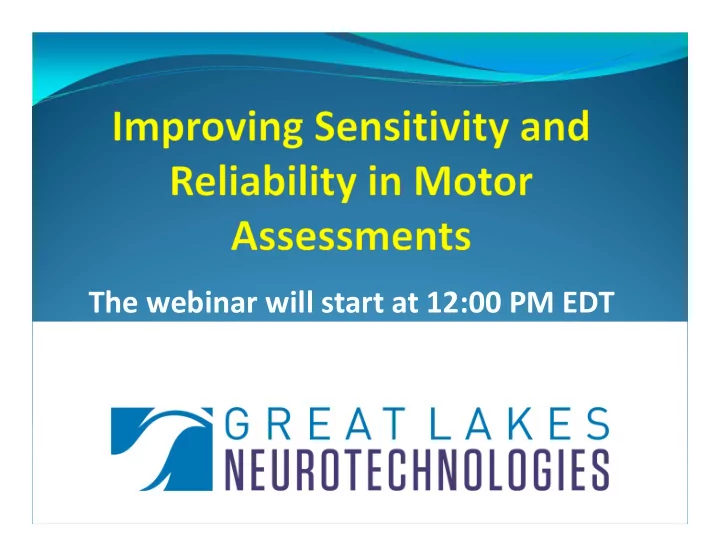

The webinar will start at 12:00 PM EDT
Topics to be covered � Problems with clinical trials � Deep Brain Stimulation (DBS) as a tool to simulate disease progression � Motion sensor sensitivity to DBS � Motion sensor test-retest reliability � Implications for clinical trials � Kinesia HomeView demo
Outcomes in Clinical Trials � Clinical Assessments (UPDRS) � Patient Diaries � Motion Sensors � Sources of error � Patient physical/mental condition � Variations in testing procedure/interpretation � Tester error � Learning effects
Problems with Clinical Trials � Clinical Assessments � Motion Sensor Monitoring � Bias � Extraneous patient movements � Placebo effects � Dyskinesias � Limited Resolution � Gravitational artifacts � Poor intra- and inter-rater reliability � Sensor noise � Patient Diaries � Compliance � Recall bias � Poor self-assessment
Clinical Trial Sample Size Considerations � The required sample size changes as a function of the reliability of the outcome measure. � Sample size decreases as reliability increases. Perkins DO, Wyatt RJ, Bartko JJ. Penny-wise and pound-foolish: the impact of measurement error on sample size requirements in clinical trials. Biological Psychiatry. 2000 Apr 15;47(8):762–766.
Deep Brain Stimulation Tool � Slowly modulate symptoms to simulate multiple disease states with relatively few subjects
Protocol Optimal 4.0 V � 18 subjects … � 13 male, 5 female 3.2 V � Age 44-76 years 3.1 V � Tasks were performed three times each at eleven DBS stimulation amplitudes Off 0 V � Videotaped for subsequent clinical rating
Assessment � Unified Parkinson’s Disease Rating Scale (UPDRS) � Resting Tremor � Postural Tremor � Finger Tapping (Bradykinesia) � Modified Bradykinesia Rating Scale (MBRS) � Finger Tapping Speed (Bradykinesia) � Finger Tapping Amplitude (Hypokinesia) � Finger Tapping Rhythm (Dysrhythmia) � Kinesia HomeView six degree-of-freedom motion sensor � 0 – 4 score based on motion data
DBS Modulation
Intraclass Correlation (ICC) ** p<0.01 ** p<0.001
Minimal Detectable Change (MDC) ** p<0.01 ** p<0.001
Sample Size Implications Number of Number of Percent Clinician Kinesia subjects subjects fewer ICC ICC based on based on subjects Clinician Kinesia 7.3 Rest Tremor 0.63 0.68 100 93 4.2 Postural Tremor 0.68 0.71 100 96 38.3 Speed 0.58 0.94 100 62 26.6 Amplitude 0.69 0.94 100 74 23.8 Rhythm 0.48 0.63 100 77
DBS Programming Recently Published Recently Kinematic optimization of deep brain stimulation across multiple motor symptoms in Parkinson’s disease Accepted for Mera TO, Vitek JL, Alberts JL, Giuffrida JP Publication J. Neurosci. Methods , vol. 198, no. 2, pp. 280–286, 2011.
Conclusions � Motion sensors can provide increased sensitivity and test- retest reliability over clinical assessments. � The increased sensitivity and reliability afforded by motion sensors over clinical assessments can decrease the number of subjects, shorten the duration, and lower the costs required detect significant outcomes in clinical trials. � Home-based motion sensor monitoring can improve temporal resolution in addition to score resolution.
Acknowledgements � Joseph Giuffrida � Alberto Espay � Thomas Mera � Angie Molloy � Christopher Pulliam � Maureen Gartner � Danielle Filipkowski � Jackson Gregory � Greg Ferreri � Mike Trivison � Peter LeWitt � NIH/NINDS 1R43NS07462701A1 � Patricia Kaminski
For more information, please contact Dustin Heldman at dheldman@glneurotech.com
Recommend
More recommend